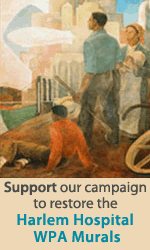 |
| 1887
|
When Harlem Hospital Center opened its doors on April 18, 1887, it was located at the juncture of East 120th Street and the East River. The Hospital was a former Victorian mansion lit with ornate gas fixtures and heated by marble fireplaces.
The Hospital’s initial purpose was to serve as a reception center for patients awaiting transfer to Ward’s and Randall’s Islands. It also served as an emergency branch of Bellevue Hospital, providing both ambulance and hospital service.
 |
| 1940
|
The Hospital assumed part of its’ present site on the east side of Lenox Avenue between 136th and 137th Streets in 1907 where it opened as a 150-bed facility. From 1907 to 1960 several expansion programs were completed, including a 390 bed expansion and a Nurses Residence in 1915; in 1935, the Women’s Pavilion was constructed adding 282 additional beds, and the Nurses Residence was expanded. In 1944, the Pediatrics Building was constructed, and in 1950, the Samuel Kountz Pavilion, a 233-bed acute and outpatient facility was constructed. The original 150-bed hospital was replaced in the late 1960s by the eighteen story Martin Luther King, Jr. Pavilion. In 1998, the Ronald H. Brown Ambulatory Care Pavilion was completed.
 |
| Today
|
Harlem Hospital Center has a long and respected reputation as an educator of Black health professionals. Although Black physicians were not appointed to the medical staff in any significant number until 1927, minority physicians have since come to dominate the medical faculty and residency training programs.
 |
| Our Vision for the Future
|
The Hospital is credited with saving the life of The Reverend Dr. Martin Luther King, Jr. in 1958. He was giving a speech at a bookstore in 125th Street when a deranged woman stabbed him in the chest. He was rushed to Harlem Hospital Center, where the Chief of Surgery, Dr. Aubrey Maynard performed a unique, complex, and innovative procedure. Dr. King had a full recovery and the fine work of the physicians and staff at Harlem Hospital Center is mentioned in his autobiography.
Today, the Hospital is a primary resource for medical practice and education for a heterogeneous mixture of professionals who are pursuing careers in health care and are dedicated to service in medically underserved areas.
The Hospital is a member of the New York City Health and Hospitals Corporation and the Generations+/Northern Manhattan Health Network.












